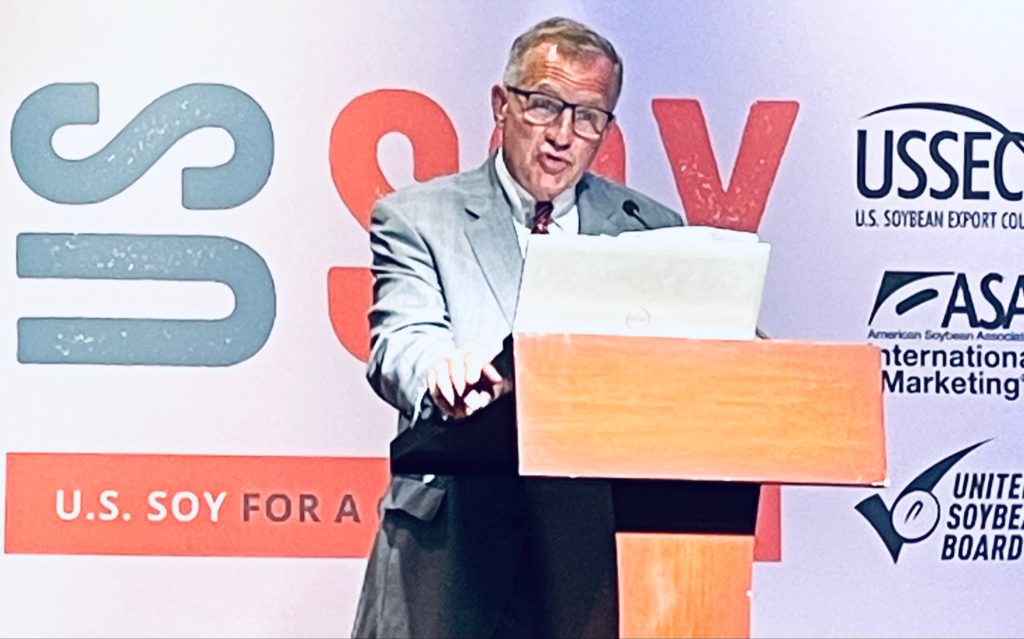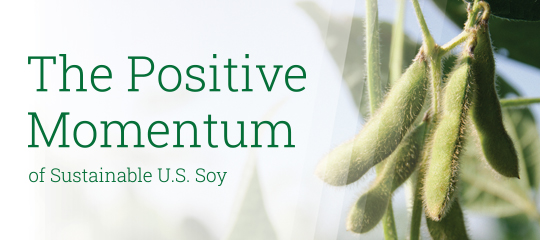
After USDA's release of the September World Agricultural Supply and Demand Estimates report, analysts and experts in the soy supply chain keep an eye on yields and export interests, including India, China and overall vegetable oil complex.
Despite projections from the U.S. Department of Agriculture for the fourth largest U.S. soybean crop on record, analysts say strong global demand keeps a tight grip on supplies.
“We are in some very exciting times in the global soy complex,” said U.S. Soybean Export Council CEO Jim Sutter. “Overall supply and demand are tight and ocean freight rates are strong.
“This is all being driven by economies that are in various stages of recovery from the global pandemic.”

In its September World Agricultural Supply and Demand Estimates report, USDA revised the average yield up by 0.6 bushels per acre to 50.6 bushels per acre, or 3.4 metric tons per hectare. Additionally, the report integrated prevent planting data, and the total area forecast for harvest decreased by 320,000 acres to 86.4 million acres (about 35 million hectares).
The net impact of these adjustments is an increase in the expected U.S. soybean crop of 35 million bushels, totaling 56.9 million metric tons, explained Mac Marshall, vice president of market intelligence for USSEC and United Soybean Board.
“Despite the increase in production, the biggest take-away here is that global balance sheets remain tight,” added Dustin Baker, manager of education and research for Commodity & Ingredient Hedging, LLC (CIH). “If we look at ending stocks of 185 million bushels in the United States of new crop, our stocks-to-use ratio is at 4.2%.
“If realized, that would rank as the third lowest in the past 30 years — only behind last year’s crop as well as the 2013-14 crop. By and large, this WASDE confirmed what we already knew: that we have robust demand, tight global supplies and that the market will continue to pay attention to yields coming out of the field as well as any export interests.”
As analysts evaluate demand shifts and the movement of soy, India has made headlines in recent weeks with its announcement of imports of soybean meal derived from transgenic soybeans until January 31, 2022.
“India represents an interesting development,” Baker said. “These revisions aren’t trivial.”
Baker said his team will pay close attention to India’s influence moving forward, as well as the fact that the country has slashed import taxes for vegetable oils.
In looking at the overall landscape of the vegetable oil market, both Baker and Marshall agree supplies are tight and buyers need to manage risk while staying flexible.
Overall, the breadth of the U.S. Soy growing belt is absorbing the weather impact in the Dakotas, which like Canada's soybean growing region has experienced drought this year and is coming in with a smaller crop compared to the prior year.
“The story is similar across all oilseed commodities because of the relative substitutability of them,” Baker shared. “I’ve been watching the shrinking canola crop in Canada throughout the summer, which has wreaked havoc on those prices.

“Given the tightness of the overall balance sheet for vegetable oils, it definitely makes it interesting to manage risk and create flexible strategies that fit each one of our client’s risk profiles.”
As analysts look at the global soy complex, one must account for China as it consumes 60% of the world’s soybean supply.
Marshall said he was a little surprised USDA revised its old-crop import number upward.
Baker attributed this revision to the expanding hog herd, as China continues to rebuild from the destruction caused by African Swine Fever.
Marshall added the consideration of the price inversion between wheat and corn and how that might impact feed rations in the short term.
“One thing I’ve heard is China increased its purchases of soymeal to get around some the prevailing low margins,” Marshall said.
Baker said CIH is also watching that dynamic play out.
“If we look at overall soybean total commitments to China for the new year, we are down 40% from a year ago as we start this new marketing year but still well above the 5-year average,” he said. “We still expect that to be a robust market, especially as we enter this harvest season.
“As China continues to build its domestic hog herd, we will continue to pay attention to this and expect it to have a large impact on U.S. prices as well.”
Baker and Marshall shared their perspective as part of the U.S. Soy September WASDE Update, broadcast Sept. 13 from Guadalajara, Mexico, where they were joined by three U.S. soybean farmers who provided a fresh from the field perspective.
Farmers included Brad Doyle of Arkansas, Josh Gackle of North Dakota, and Lance Rezac of Kansas.
Listen to their update below.
After listening to the market analysts and farmers share their view and perspective, Sutter said one of his key take-aways is that despite some of the production challenges farmers in the Dakotas and northern tier of the United States have faced, the soybean-growing geography is wide enough and yields strong enough to compensate for one region’s weather challenges.
This story is sponsored by the United Soybean Board.
